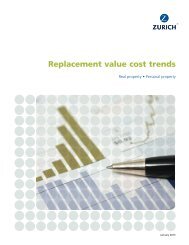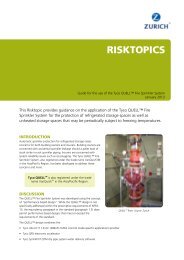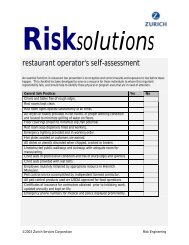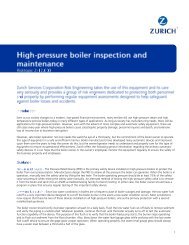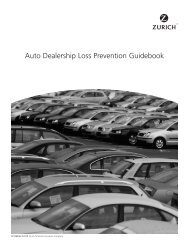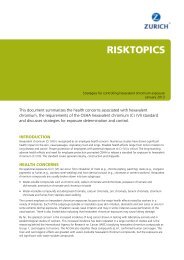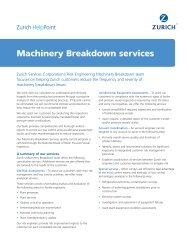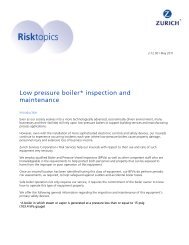Self-inspection for food processing plants - Risk Engineering
Self-inspection for food processing plants - Risk Engineering
Self-inspection for food processing plants - Risk Engineering
Create successful ePaper yourself
Turn your PDF publications into a flip-book with our unique Google optimized e-Paper software.
Is there a batch/date coding <strong>for</strong> the finished products? Are testing procedures <strong>for</strong> raw materials, processes,and products documented?Is there a product label review program? Does the product label comply with the regulatory requirements?Is there a written recall program?Is there a documented Hazard Analysis and Critical Control Point (HACCP) Program in place?Storage/Handling of hazardous materials Do you comply with Hazards Communication Standards? Are materials such as pesticides, herbicides, cleaning solvents, lubricants, and boiler compounds accessible <strong>for</strong>use only by authorized employees? This will help prevent accidents such as <strong>food</strong> contamination andemployee injury due to ignorance and misuse. Are all hazardous materials kept in appropriately labeled containers, drums, or boxes that reflect theirdangerous nature? Nonhazardous materials should also be labeled correctly.Pest controlIf you hire an outside pest control operator, you should: Check credentials, license and reputation Check regularly on what the pest control operator is doing. Don’t accept what he’s doing on faith. Learn bait station locations and the number provided. They should be placed so as to present no chanceof <strong>food</strong> contamination. They should be checked regularly. Check to see if fumigators are being used. Do they represent a hazard to employees or <strong>food</strong> safety?If you are doing your own exterminating, you should: Obtain certified applicator certification from the state. Know there is no such thing as an all-purpose pesticide, especially where <strong>food</strong> is concerned. Getqualified advice be<strong>for</strong>e using any poisons. Make a map showing locations of all traps, bait stations, etc., and check them regularly. Invest inbuilding maintenance if that will help solve pest problems. For instance, don’t rely solely on rodenticidesto control your pest problem and leave gaps in the doors <strong>for</strong> rodents to enter. Make sure those gaps aresealed. Extermination is a poor second choice and will cost you as much, or more, in the long run.SummaryAn ongoing program of self <strong>inspection</strong>, sanitation, pest control, and scheduled maintenance provides a strongfoundation to help in maintaining a safe, quality <strong>food</strong> <strong>processing</strong> and storage operation.References1. “Current Good Manufacturing Practices in Manufacturing, Processing, Packaging, or Holding Human Foods.”Food and Drug Act (21 CFR Part 110).2. “Do Your Establishment Inspection – A Guide to <strong>Self</strong> Inspection <strong>for</strong> the Smaller Food Processor andWarehouse.” FDA Publication 82-2163.3. Quality Assurance Manual <strong>for</strong> Food Processors. Manhattan, KS: American Institute of Baking.



